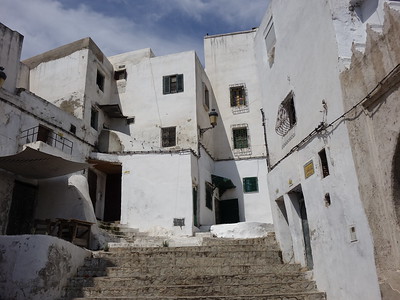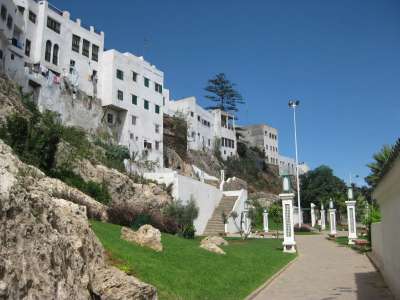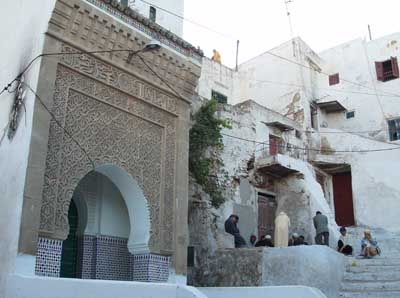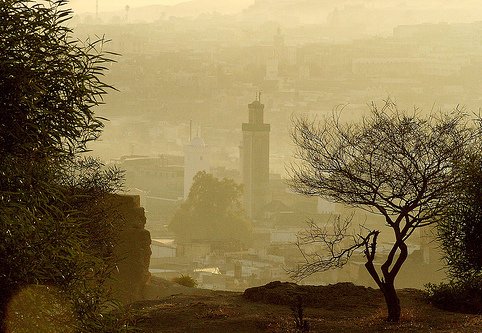Medina of Tetouan (formerly known as Titawin)








Tetouan was of particular importance in the Islamic period, from the eighth century, as the primary point of contact between Morocco and Andalusia. After the Reconquest, the town was rebuilt by returnees to this region after being expelled by the Spanish. This is visible in the architecture and art which reveal clear Andalusian influence. This is one of the smaller Moroccan medinas, but undoubtedly the most complete, which, subsequently, most buildings remained to outside influences.
Other languages:
English French Spanish Arabic Chinese Russian
Jbel Dersa © Anassbarnichou2 More images ...
Outstanding universal value
Brief summary
The Medina of Tetouan has grown on the steep slopes of the Jebel Dersa. She had a particular importance in the Islamic period, from the eighth century, as the primary point of contact between Morocco and Andalusia. After the Reconquest, the town was rebuilt by returnees to this region after being expelled by the Spanish. This is visible in the architecture and art which reveal clear Andalusian influence. This is one of the smaller Moroccan medinas, but undoubtedly the most complete, which, subsequently, most buildings remained to outside influences.
The Medina of Tetouan is surrounded by a wall of history about 5 km long and access is through seven gates. The urban fabric is characterized by the main roads connecting doors giving access to each other and, on the one hand to open spaces (and small squares) and the monuments of collective interest such as fondouks, mosques, and zaouias areas for crafts and trade and, secondly, the secondary roads that lead to dead ends and residential blocks forming semi-private spaces. Real synthesis of Moroccan and Andalusian culture, the historic city of Tetouan has specific urban and architectural that influenced the architectural and artistic development at the time of the Spanish protectorate. The city of Tetouan is very famous for its School of Arts and Crafts (Dar Sanaa) and its National Institute of Fine Arts that reflect an ancient tradition and an openness to the world today.
Criterion (ii): The Medina of Tetouan reflects considerable influences of Andalusian civilization in late medieval times to the Muslim West. This is evident in the development of architecture, monumental arts and town-planning.
Criterion (iv): The Medina of Tetouan is a remarkable example of a fortified city on the Mediterranean coast, backed by a mountain landscape in northern Morocco. It shows an ancient occupation and during the Islamic period, it is of considerable importance, since it is the only passage between the Iberian peninsula and the interior of Morocco. Its rise from the early seventeenth century continued until the late eighteenth century and is reflected in its fortifications, its architecture, synthesis of Moroccan and Andalusian cultures, and its urban fabric.
Criterion (v): The strategic position of the Medina of Tetouan across the Strait of Gibraltar has played an important role as a junction point and transition between two civilizations (Spanish and Arabic) and two continents (Europe and North Africa).
Integrity (2009)
The property boundary includes all attributes that are necessary to express its outstanding universal value. Some attributes require conservation measures. The priority for conservation work is given to walls, doors and borjs (fortified watchtowers). The municipality is cooperating with the government of Andalusia (Spain) to perform rehabilitation work at the heart of the medina.
Authenticity (2009)
The authenticity of the medina is illustrated by its original urban fabric virtually intact and pregnant with its initial configuration, gates and fortifications. Their built in the eighteenth century and they still retain their shape and original materials. The medina has an original fabric that is characterized by the hierarchy of roads and the distribution of residential, commercial and backyard following a definite pattern. The real estate as a whole, as the zaouias, fountains, steam rooms, kilns, silos and historical, have kept their authenticity, whether in their shape, construction materials, and in their ornamentation or even, for some, in their function. The majority of homes are intact although some floors were added illegally and internal separations were performed.
Needs protection and management (2009)
Protection measures are essentially different laws listing of historic monuments and sites, particularly the law 22-80 (1981) on the Conservation of Moroccan heritage. There is a willingness and a strong belief among relevant departments, authorities and local associations to preserve and conserve the property. Responsibility for management and conservation is both the municipality, the planning department, local authorities and the Ministry of Culture. Being legally responsible for the conservation of cultural heritage in general, it directs and assists the various departments in their efforts for the preservation and conservation of the medina. The procedures and priorities are determined by the conservation recommendations and guidelines taken as part of the master plan study of the city of Tetouan. Development plans on regional and local medina are summarized in the Master of Tetouan, developed by the Department of Housing and Regional Planning in 1982, which gives great importance to the conservation and rehabilitation of the medina. The Spatial Development and Regional Planning from the northwestern region produced by the Regional Planning, Architecture and Planning in February 1996 has among its objectives, the obligation to retain and medina rehabilitation. The creation of the Regional Directorates of Culture since 2006 is in line with the establishment of an integrated conservation policy for local development policy. The development plan of the medina of Tetouan includes provisions for the conservation and management and takes into consideration the universal value of the site.
Long Description
[English only]
The Medina of Tetouan is year Exceptionally well-preserved example of full and this kind of historic town, displaying all the features of high Andalusian culture.
The origins of Tetouan are Not known, aim the discovery of archaeological sites, from prehistory and the classical period (Phoenician, Roman and Mauritanian-Punico) in the immediate surroundings of the town attest to the antiquity of the settlement of the valley in general Oued Martil and the site of Tetouan In Particular.
In the Islamic période the Tetouan Region Became very significant as the only connection Between the Iberian Peninsula and the interior of Morocco. As a result, a number of towns Grew up, Such as Ceuta, Tangier and Qasr es-Saghir. Tetouan is Mentioned by a number of Arab writers of the 10th-12th centuries, fired, return not aim it assumes significant role Until year the after the fall of Ceuta and Other centers on the coast to Spanish and Portuguese troops Towards the end of the Middle Ages.
A fortified garrison (Kasbah) HAD beens installed at the site of Tetouan by Sultan Abu Yusuf Yaqub al-Marini in 1286 to block Ceuta. The town grew up in the early 14th century, goal WAS sacked and completely Call Destroyed by Spanish forces has century later. It Was rebuilt at the end of the 15th century by a group of Refugees from Andalusia During The Reign of Sultan Mohammed ash-Shaykh al-Wattassi. The late 15th-century town was small, the characteristics of, the present-day al-Balad quarter and a kasbah, built to the Requirements of Abu al-Hassan Ali al-Mandri, military leader of Banu al-Ahmar of Granada.
The second internship in ict development cam in the mid-16th century medina When The WAS extended to the south-west, the al-Rabat Asfal quarter. Finally, the arrival of the Moriscos (Spanish Muslims forcibly to Christianity and later her assets Expelled from Spain) from 1609 onwards led to a further Top expansion of the medina Towards the north-west. This Continued Until the mid-18th century, rebuilt Were When The fortifications, the medina to Give icts Existing Configuration.
Developed Tetouan on the stepped slopes of the Jabal Dersa. It Consists of Two quadrilaterals of more or less EQUAL size ALONGSIDE Each Other, Giving overalls year outline of a figure-of-eight.
The defensive walls are about 5 km long, with a number of Buttresses and defensive works on the exterior of the wall, Such as the bastions of Bab Bab al-Oqla and in-Nwader on the north and the star-shaped bastion at the north -east corner. Access is by means clustering of seven historic gates. Inside, the medina is crossed by the main streets linking gates with plans blew. These provide statement moyen de access to open spaces, to public buildings Such as the funduqs (inns), mosques and zawayas (religious speakers), and to the artisan and trading quarters. Lanes lead from the main streets to private residential quarters.
Source: UNESCO / CLT / WHC
Historical description
The origins of the city of Tetouan are still unknown, but the discovery of archaeological sites from prehistoric and classical times (Phoenician, Punic and Roman-Mauritania) in the immediate environment of the city testify to ancient occupation WLE Valley of the Oued Martil in general and the particular site of Tetouan.
During the Islamic period, the region of Tetouan is WLE considerable importance, since it is the only passage between the Iberian peninsula and the interior of Morocco. Several cities then come out of earth, like Ceuta, Tangier and Ksar-es-Saghir. Between the 10th and 12th centuries, Tetouan is mentioned by various Arab writers, but not until the late Middle Ages after the fall of Ceuta and other coastal centers in the hands of Spanish and Portuguese troops, to see the play an important role.
In 1286, Sultan Abu Youssef Yacoub el-Marini erected a fortified garrison (Casbah) on the site of Tetuan to Ceuta block. In the early 14th century, the city grows, it will be looted and completely destroyed by Spanish forces Wl century later. It was rebuilt at the close of the 15th century during the reign of Sultan Mohammed ash-Sheikh ei-Wattassi by Wis. group of refugees from Andalusia. At the end of the 15th century, the city is not very extensive: restricted to the current district of al-Balad and fortified kasbah Wie, she meets the requirements of Abu al-Hassan Ali elMandri, military leader of Banu ei-Ahmar of Granada.
The second phase of its development began in the mid-16th century, with the extension of the medina to the southwest (area of Rabat did Asfal). Lastly, from 1609, the arrival of the Moriscos (Spanish Muslims forcibly converted to Christianity and later expelled from Spain) WLE contributes to further expansion of the Medina, to the northwest this time (district of Rabat al-Aala). This growth continues until the middle of the 18th century reconstruction of the fortifications which will give the medina its current configuration.
























